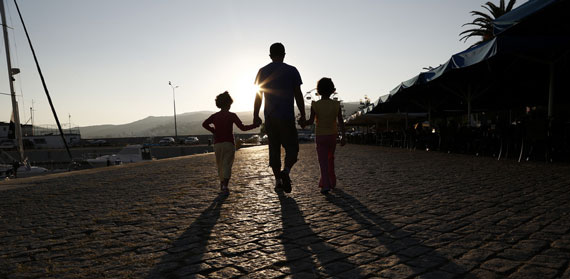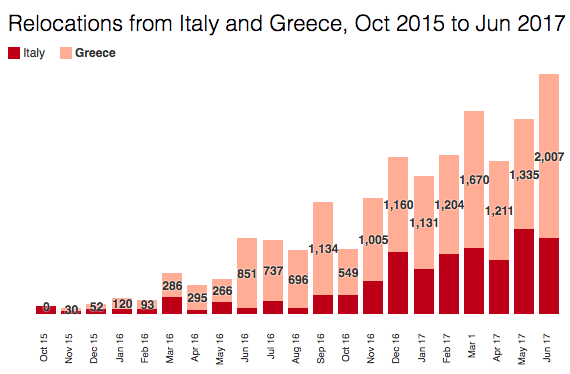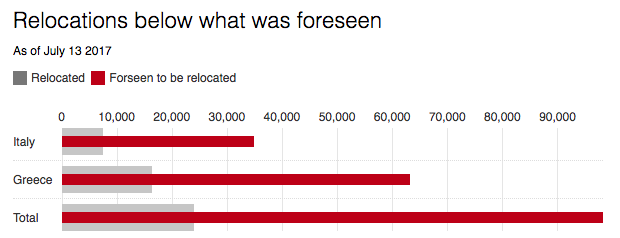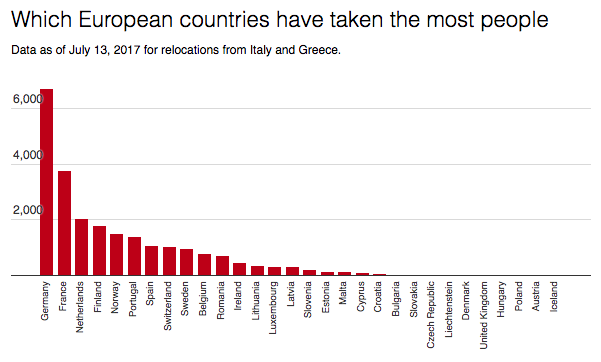A Syrian refugee and his two daughters wait for relocation in northern Greece. Yannis Kolesidis/EPA
Guest post by Professor Heaven Crawley, Centre for Trust, Peace and Social Relations
There are currently an estimated 22.5m people living as refugees around the world. On July 10, representatives from more than 80 countries gathered at the Palais de Nations in Geneva to discuss how best to share responsibility for them. Organised by UNHCR, the discussion will inform a new Global Compact on Refugees which is being developed in the hope of addressing the long-term challenges associated with displacement.
The starting point is simple but important. The vast majority (84%) of those forced to leave their homes now live in low and middle-income countries. Turkey, for example, hosts more than three million Syrian refugees alone, Lebanon a further 1.5m. In the absence of protection and opportunities to rebuild a life, some of these people will move elsewhere with all the associated human, financial and political costs that this entails. Countries with more resources could, and should, do more.
But Europe faces a responsibility sharing crisis of its own.
Over recent years, the majority of refugees have crossed the Mediterranean by boat arriving almost exclusively in just two countries: Italy and Greece. Under the Dublin Regulation, people seeking protection in Europe have to apply for asylum in the first EU member state they reach. In 2015, this meant that Greece, already reeling from the effects of economic crisis and austerity measures dating back to 2010, suddenly became responsible for 850,000 people arriving on its shores, mainly from Syria, Afghanistan and Iraq. A further 150,000 were rescued at sea and taken to Italy.
Greece already had a deeply flawed asylum process and limited reception facilities. Unable to cope, it effectively persuaded Macedonia to open its borders and allow people to move on, primarily to the countries of northern Europe. It was only at this point that Europe’s leaders decided something needed to be done.
Relocation, relocation
That something turned out to be relocation.
The process of relocation involves distributing those people who arrive in Europe and are considered to need international protection to other member states with fewer arrivals. Relocation was intended to be a clear expression of solidarity between EU countries. In July 2015, it was agreed that 40,000 people would be relocated from Greece and Italy. This number was increased by a further 120,000 in September that year.
The distribution of people across different countries was calculated using objective and quantifiable criteria. Those defined as vulnerable – children, pregnant women, the elderly and those who had experienced torture, rape and other forms of gender-based violence – were to be given priority. Where possible, family connections in European countries would be taken into account when deciding where someone would be sent. The scheme would last two years, ending in September 2017.
But from the moment relocation began in October 2015, it was painfully slow. In the first few months, just a few hundred refugees were moved out of Italy and Greece even as tens of thousands more were arriving every day. By March 2016, six months after the scheme started, just 937 refugees had been relocated. Nothing much changed during 2016. By the end of the year, 8,162 people had been relocated (6,212 from Greece and 1,950 from Italy) representing just 5% of the total originally agreed.
Source: European Commission
The latest figures released by the European Commission provide slightly better news, with a significant increase in the number of people relocated since the start of 2017. As of July 13, the total number of relocations stood at 24,092 (7,615 from Italy and 16,477 from Greece).
But with only two months to go before the scheme is scheduled to end, the idea of relocation as a mechanism for sharing responsibility is clearly in trouble.
So what went wrong?
There are three main reasons why relocation has failed to deliver on its promises.
First, only those with a high chance of having their applications successfully processed are eligible for relocation. This means people are only eligible if they come from countries in which more than 75% of asylum seekers have been recognised as refugees under the strict criteria of the 1951 Refugee Convention. As of July 1, the only countries meeting this criteria were Eritrea, Bahamas, Bahrain, Bhutan, Qatar, Syria, United Arab Emirates and Yemen.
The problem is that refugee recognition rates across Europe are generally low and also vary considerably between member states, even for those coming from the same country. This means that while some people, such as Syrians, are eligible for relocation, others, for example those coming from Iraq or Afghanistan, are not. The strict criteria mean that very few of the hundreds of thousands of people who have arrived in Europe since March 2015 can actually be relocated. The fact that Bahrain and the Bahamas are on the relocation list simply because there are very few applications from these countries and the acceptance rate is high, reflects the arbitrariness of the eligibility criteria.
Second, virtually no European countries have delivered the number of places originally agreed. This is due, in part, to inadequate facilities for identifying, informing, processing and transferring relocation applicants, particularly in the early days. But countries have also cited “security concerns” or expressed preferences about the people they are ready to accept based on factors such as nationality and family status.
Some countries have openly discriminated. Slovakia, for example, will only accept Syrians who are Christian. This has significantly complicated the matching process. There is also some evidence of countries “cherry picking” refugees with particular qualifications or professional skills.
Source: European Commission
Third, while some countries have taken quite a few refugees – Germany, for example, had taken 6,738 people by July 13, almost a third of the total – others have simply refused to relocate refugees at all. This undermines the principles of solidarity and responsibility sharing on which the relocation scheme was based.
The UK, Ireland and Denmark opted out of the scheme from the beginning. Others, such as Hungary and Poland, have not relocated any refugees to date. The Czech Republic has relocated just 12 of the 2,691 agreed. It is only due to pressure from the EU, including threats of legal action in June 2017, that relocation has increased at all.
Source: European Commission
A moving target
Relocation has now become a moving target. When it became clear that the scheme was failing, the EU reduced the target from 160,000 to 98,000, citing a lack of people eligible for the scheme. With just a few months to go until September 2017, the target was reduced again in April, this time to just 33,000 places. Although the legal obligation to relocate refugees will continue beyond the end of the scheme, it is difficult to imagine that the number of people relocated will go beyond the new target.
These problems reflect the underlying issues that go to the heart of both the European and global response, namely a lack of solidarity and responsibility sharing for the world’s refugees. Even as UNHCR calls on countries to move from rhetoric to practice and make “the rubber hit the road”, it is increasingly clear that Europe’s car is still sitting in the garage trying to find a way to put the wheels back on.
Originally written for ‘the Conversation’.







Comments are disabled